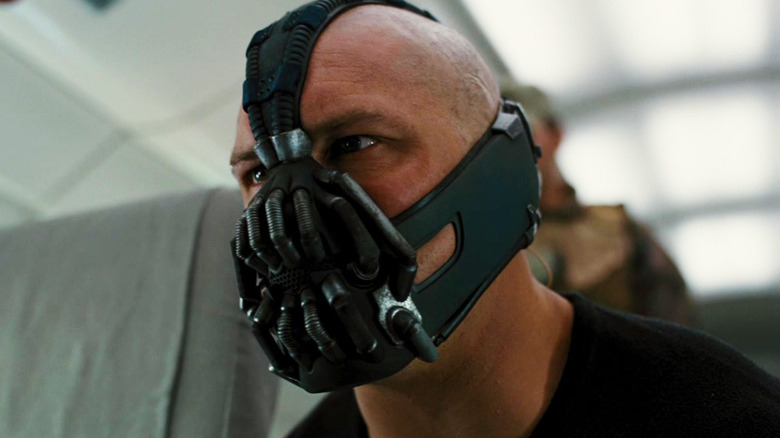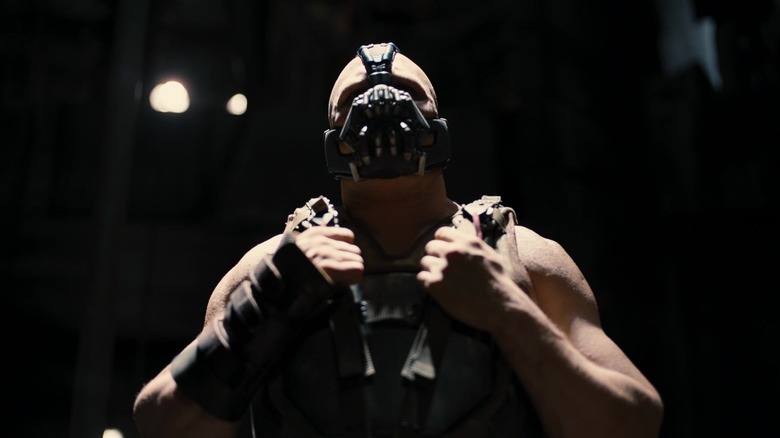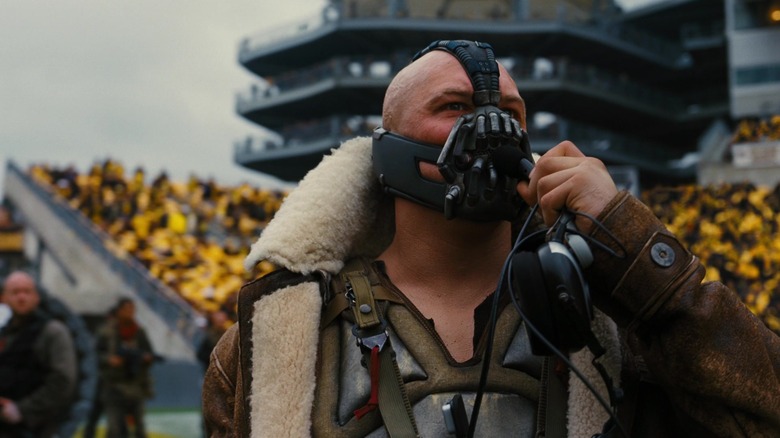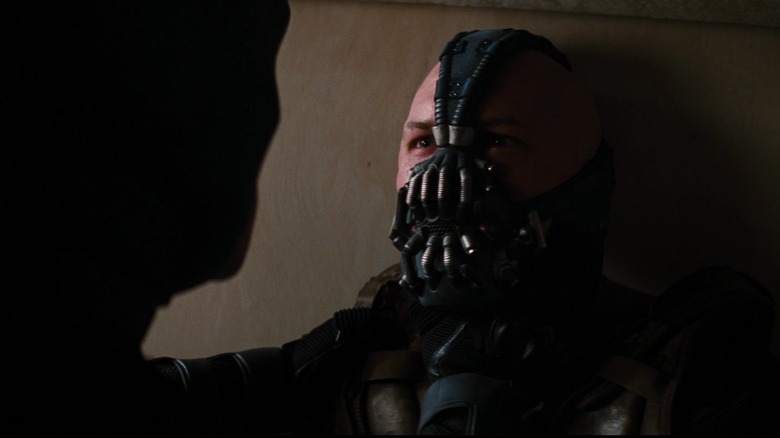Why Tom Hardy's Bane Wears A Mask In The Dark Knight Rises
Of all the films in Christopher Nolan's "Dark Knight" trilogy "The Dark Knight Rises" isn't the most fondly remembered. Sure, it made $1 billion at the global box office and was arguably the most ambitious superhero movie ever made in terms of its scale. But Nolan was always going to struggle to follow the zenith that was 2008's "The Dark Knight," and in many fans' estimations, struggle is exactly what he did.
Much has been written about the issues with "Rises" so we'll spare you yet another critique. In fact, we'll go one better and say there's a lot to like about the film, Marion Cotillard's controversial death scene notwithstanding. Aside from Nolan's always impressive in-camera action set-pieces, the film also featured some great performances, with Tom Hardy's Bane becoming almost as big a cultural phenomenon as Heath Ledger's Joker from the previous installment. Sure, most of that was down to his voice, which represented the latest in a long line of weird Tom Hardy accents that teetered on the verge of being distractingly comedic. But there's no doubt the British actor delivered an original take on the classic Batman rogue, projecting a palpable sense of menace and simmering anger.
Not everything about Hardy's Bane was original, though. While Nolan famously put his own spin on the Batman mythos, and often outright changed major elements of it, he also borrowed quite a bit from the comic book lore, including Bane's mask which has been a key element of the character since his debut in "Batman: Vengeance of Bane" #1 from January 1993. The story behind the mask, however, was changed for "The Dark Knight Rises," with Nolan giving Hardy's villain a tragic genesis that required he wear the mask at all times.
Bane was left in chronic pain after being attacked in the Pit
In Christopher Nolan's first Batman movie, 2005's "Batman Begins," Christian Bale's Bruce Wayne is taken in by Liam Neeson's Ra's al Ghul and the League of Shadows, where he receives his combat training. By the movie's end, Ra's and Bruce become mortal enemies, and the latter leaves the former for dead, seemingly ending his and the League of Shadow's quest to bring Gotham to its knees.
In "The Dark Knight Rises" Bane arrives in Gotham with similarly destructive intent. But it's not until later in the film that we learn Tom Hardy's villain is also a former League of Shadows member who, alongside Marion Cotillard's Talia al Ghul, is intent upon finishing what Ra's started and finally destroying Gotham once and for all. This is an important revelation not only for the film's narrative overall, but for explaining Bane's mask, which hints at an unseen part of his past.
After Bruce is captured and sent to an underground prison in the Middle East named the Pit, a prisoner, played by Tom Conti, explains that Ra's al Ghul had a child (Talia) who was born and raised in the Pit. Talia managed to escape the prison with the help of Bane, who was attacked by a group of inmates as a result, leaving him in constant pain. As Conti's prisoner explains, "Some of the other prisoners attacked Bane. And the doctor's fumbling attempts to repair the damage left him in perpetual agony." It was this that led to the creation of a mask which would allow Bane to function in spite of his unending pain and which was likely provided by Ra's after Bane joined the League of Shadows in the wake of his own escape from the Pit.
Bane's mask delivers an anesthetic to numb his pain
In "The Dark Knight Rises" Bane's mask serves a crucial purpose, beyond making it really hard to make out what the heck Tom Hardy is actually saying — though some of that had to do with Hardy basing his Bane voice on a real-life legend who wasn't the easiest to understand in the first place. Specifically, the mask helps deliver an anesthetic gas which numbs Bane's chronic pain enough that he's able to function. As Christopher Nolan explained to Rolling Stone (via Batman News): "Bane is someone ravaged by pain from a trauma suffered long ago, and the mask dispenses a type of anesthetic that keeps his pain just below the threshold so he can function." Essentially, then, the mask is a sort of inhaler that delivers a constant supply of aerosolized anesthetic to Bane.
In an Empire interview (also via Batman News) costume designer Lindy Hemming went further in explaining the specifics of Bane's headwear, saying:
"He was injured early in his story. He's suffering from pain and he needs gas to survive. He cannot survive the pain without the mask. The pipes from the mask go back along his jawline and feed into the thing at the back where there are two canisters of whatever it is, the anesthetic."
The mask's function is alluded to in the opening moments of "The Dark Knight Rises" — which feature an action sequence that was more real than you think — when Aidan Gillen's CIA agent Bill Wilson asks Bane, "If I take off that mask, will you die?" to which the villain responds "It would be extremely painful." In the film's climax, this is exactly how Batman defeats Bane, using his gauntlets to damage his mask and rendering the villain completely ineffective.
How Tom Hardy's Bane mask differs from the comics
Bane — who is said to be teaming up with another DC villain in an upcoming film from James Gunn's DC Studios — has been a part of the Batman universe since his introduction in 1993's "Batman: Vengeance of Bane," ultimately becoming one of the most recognizable rogues in the Dark Knight's infamous gallery. But the comic book version of the villain differs significantly from the character played by Tom Hardy in "The Dark Knight Rises."
In the comics, a young Bane was sent to the South American prison of Peña Duro, a nightmarish complex situated on the island nation of Santa Prisca. His father, Edmund Dorrance, was a revolutionary who managed to escape capture, leading the authorities to demand his young son serve out his father's life sentence. In prison, Bane becomes a test subject, gaining super strength after he's subjected to an experiment involving the drug Venom. Similar experiments had killed prior test subjects, but after Bane survives he becomes addicted to the substance and requires doses every 12 hours.
It's here that the mask comes in. Designed to deliver regular doses of Venom directly to Bane's brain, the mask is essential to the villain retaining his immense strength and avoiding withdrawal symptoms. In that sense, Bane's mask in the comics is just as crucial as the version in "The Dark Knight Rises," as the withdrawal symptoms would likely be just as excruciating as the pain Hardy's character endures without his own mask. Still, there is no mention of Venom in Christopher Nolan's "Dark Knight" trilogy (which happened to be shaped by a shameless studio note).



